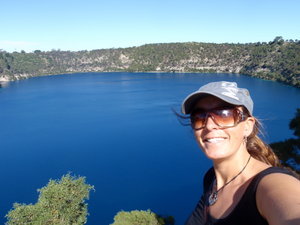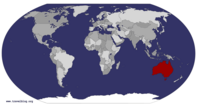Advertisement
Published: February 19th 2010

 The Blue Lake
The Blue Lake
Mt Gambier, SA21st December - 24th December 2009
Robe, Mt Gambier & Port Mac Donnell
Mum flew home after a few relaxing days back in Gawler with the family and a day trip into the Barossa for some wine tasting. I spent the following week at Gawler with my cousin and family, getting my christmas shopping done and hanging out with the kids and dogs. I went to my cousin's husband's parents 50th wedding anniversary which was a really special night. The family is massive and it was lovely to be welcomed into their family. It turns out that my cousin and family are going up to Darwin for a month over the school holidays and asked if I would like to house sit. After realising I had nowhere to be in the next month I thought why not? What a great opportunity to stay here for a month. It will be quite a handful with all their animals but I love them all and the house is a lovely big family home so I am really looking forward to it. They plan on leaving on the 27th December, so I get to spend Christmas with them which is lovely. When
you are travelling on your own, I thought I would probably end up somewhere in the middle of nowhere celebrating Christmas on my own. Not my idea of fun. So if I can help my cousin out and get the chance to stay in a really nice part of the world for a month, then it sounds good to me.
With the decision made to stay in Gawler for the next month I decided to do a short trip down to the Limestone Coast at the very bottom of South Australia before they left. With the responsibility of looking after all the animals I really can't go anywhere overnight so I thought I better get down there now. I headed down through the Adelaide Hills stopping at the Big Rocking Horse at Gumeracha. The Big Rocking Horse is a classic toy shop where they make wooden toys. That's right the traditional wooden toys you see on Christmas movies with the elves making at the North Pole. It is so brilliant and the toys are awesome. I think more kids should be playing with these toys. There is an animal park and cafe at the Big Horse and you can
even climb to the top if you feel so inclined.
I continued on through the Adelaide Hills making my way back down the road that Mum and I had come through on when we were making our way back from Kangaroo Island. I decided to take the coast road from Tailem Bend (B1) that follows the Coorong National Park down the coast to Kingston S.E. It was late afternoon so it was a very pleasant drive along the coast (even through you can't see the water the scenery is still lovely). I didn't stop at Kingston S.E. as I wanted to get to Robe for the night. Kingston S.E. is home to 'Larry' the Big Rock Lobster (I guess after the Rocking Horse I was into BIG things). Australia is full of the 'Big' something or others. I think it's great. The funny story with the Big Rock Lobster is that it was never suppose to be that big. Apparently it was only suppose to be a third of the size that it is but someone read the plans wrong (Larry is 18.2 m high). Obviously this part of the coast is famous for rock lobsters, from Kingston S.E
right down to the bottom at Port MacDonnell. I guess the Big Rock Lobster was a good thing after all.
I arrived at Robe late and checked into the caravan park beside the lake. First impressions of the town tell me this is a popular holiday spot and the town has a certain charm about it. Lots of stone cottages and classic beach shacks, a beautiful hoop pine lined foreshore and gorgeous bay and beach. The main street is full of cafes, gift, surf and antique shops. It is very pleasant to just stroll up and down the street and sit in the park with a picnic lunch. I went for a drive out to the point where the famous Cape Dombey Obelsik sits proudly. Built in 1853 as a navigational guide to assit boats into the Bay, it is a reflection of the areas strong boating history. There are some beautiful walks around the headland and a number of tiny bays and beaches to explore.
I drove out through the country, pass the massive pine tree plantations that line the highway on the road into Mt Gambier. Mt Gambier is home to the 'Blue Lake' and is
South Australia's second largest city. The city has been built on top of a extinct volcano with the area having a really fascinating geological history. The area features volcanic craters, lakes, caves, sinkholes, mysterious underground waterways and is also home to the State Heritage Areas of the Cave Gardens Reserve and Mt Gambier Crater Lakes Volcanic Complex. The Crater Lakes Complex is made up of four craters - Blue Lake, Browne Lake, Valley Lake and Leg of Mutton Lake. The Crater Lakes Complex is recognised as one of 57 international 'geoparks' known as the Kanawinki Geoark. A geopark is a territory encompassing one or more sites of significance and that doesn't just have to be goelogical, it can be archaeological, ecological or cultural significance as well. The Kanawinki Geopark is Australia's most extensive volcanic province, being recognised as one of the most significant and largest provinces in the world. This truly is a unique and important area of Australia.
I didn't really know what to expect when I arrived in Mt Gambier, I hadn't really done my research on this place before I arrived so I kind of was just winging it. I followed the signs up to the
Blue Lake and I kid you not my jaw hit the floor. It is one of the most stunning things I have ever seen. The day was perfect and the lake was the most electric colour of blue I have ever seen. The road goes right along the edge of it and I couldn't concentrate on driving as I was just so in awe at this amazing crater. I pulled off and parked and admired the view from ever possible angle I could find. I walked around the Lake (3.6km) and there are lookouts and viewing decks to sit and gaze at the magnificent blueness. I really came at the best time of year because during winter it is a steel grey colour and changes in summer to this brilliant turquoise blue. It is the only lake in the world that is known to change colour so dramatically. Why does it change colour?In summer when the water warms the limestone precipitates out of the water and binds to the humic substances in the water and they sink thus the natural blue colour of the water is more evident during these months. In winter the humic substances (which come from algae

 The Blue Lake
The Blue Lake
Mt Gambier, SAand land vegetation) is evenly mixed in the water column and as humic substances tend to absorb blue light the water, the lake takes on a more grey colour. I'm so glad I visited when I did, I just can't believe the colour of this lake and I wouldn't want to see it any other way. Mind you now I am curious to see it in the winter to see the difference.
The average depth of the Blue Lake is 70m and the lake contains roughly 36,000 million litres! It is the source of water for Mt Gambier and therefore no swimming or diving is allowed in the lake. There is no way you can get down to the water's edge as the sides of the crater are too steep. There is a great walk up to the highest point of the craters where the Centenary Tower looks down over the Crater Lake Complex, Mt Gambier city and the surrounding countryside. The views from up top of the tower are just outstanding. The tower was built in 1904 to commemorate the centenary of the sighting of Mt Gambier by Lt. James Grant from onboard his ship the Lady Nelson.

 The Blue Lake
The Blue Lake
Mt Gambier, SAInside the tower are pictures of the lakes from the 1800's to the early 1900's. It is really interesting to see the changes in the lakes sizes and how the Browne Lake is no longer there.
Another interesting place to visit at Mt Gambier is the Umpherston Sinkhole. Once a cave formed through the dissolution of the limestone, this sinkhole was created when the top of the chamber fell to the floor of the cave and has been beautifully landscaped creating a 'sunken' garden. Mt Gambier is an amazing place to visit with such a interesting and unique set of lakes, sinkholes and caves to explore. One thing that I didn't get the time to do was visit Engelbrecht Cave. This complex of caves under the city was first explored in 1884 and shows the unique water dissolution process where caves and sinkholes are formed. One of the best things about this cave is that you can go cave diving beneath the city streets, a truly different experience for any diver. I will be back someday to try this out even through the idea of cave diving freaks me out a little.
I made a quick trip down
to Port MacDonnell one afternoon to wander the beautiful coastline. Known as 'Australia's Southern Rock Lobster Capital' it is a hub of fishing boats and anglers. I enjoyed some fish and chips at one of the many 'chip' shops and soaked in the atmosphere of this coastal town. I really needed much more time to explore this interesting area but with Christmas only 2 days away it was time to head back up to Gawler. I hope to get back here at some point in my travels as I don't think I even scratched the surface of what there is to see and do here. It was a wonderful trip and I'm very glad I popped down for a few days. That Blue Lake is just something else!
Advertisement
Tot: 0.145s; Tpl: 0.027s; cc: 11; qc: 25; dbt: 0.0993s; 1; m:domysql w:travelblog (10.17.0.13); sld: 1;
; mem: 1.1mb




















